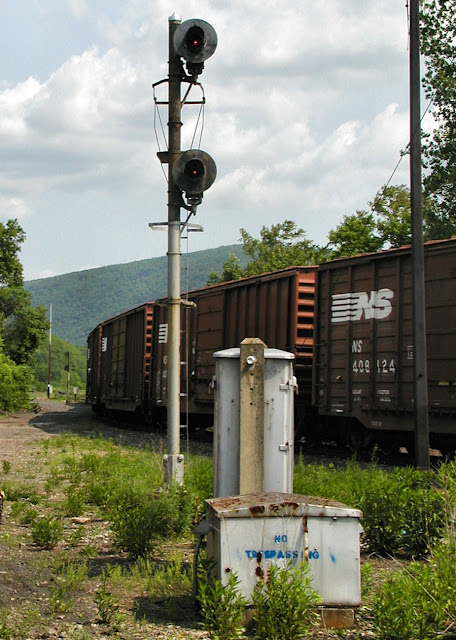This came up as I was recently out along the New Englande Central near Bellows Falls, VT when I noticed something strange at the north end of the Walpole siding.
The southbound searchlight mast was displaying an Approach Medium and my first assumption was that the signal at the Bellows Falls diamond crossing was still at Stop and due to the short distance between the south end of the siding and said diamond crossing, the signal at the south end of the siding would be displaying Approach. This is a pretty common technique to deal with a short block without using a flashing Advance Approach indication.
Well, you can imagine my surprise when I traveled back to the south end of the siding to discover a Medium Clear indication for the normal route over the single trailing point switch. The signal for the Bellows Falls diamond, about 1500 feet to the south, was also displaying clear. So, what is going on here? My first thought was that this was some kind of zombie route. The New Englande Central flipped the orientation of the turnout to create a zombie route, but didn't have the wherewithal to alter the signaling. These sorts of double track passing points where trains enter a short stretch of double track ABS on a normal route and exit on a diverging route, were that uncommon in the early CTC era. The north end of the siding even looked a little suspicious with a bracket-dwarf arrangement that could have once been a normal mast and center mounted dwarf.
The other hypothesis is that this is due to speed control over the Bellows Falls bridge. Using signaling to encourage speed control, typically involving slow speed signals, wasn't unheard of in the pre-PTC world. Although Approach Medium to a Medium Clear over a straight route is quite out of the ordinary, The train approaching the interlocking will be traveling at medium speed per rule with the Medium Clear further acting as a reminder. After the 2016 Amtrak Frankford Jct derailment the FRA leaned heavily on various passenger railroads to use signals less favorable than Clear to help prevent accidents at significant speed restrictions. Since the Bellows Falls Bridge is 10mph compared with 50-60mph approach speeds, this seems like the sort of remedy the FRA would require on a PTC exempt rail line.
So which is the more likely scenario? Well, the answer would come from YouTube of all places. If you remember back to that interlocked diamond crossing at the Bellows Falls passenger station, the northbound signal is at the end of the platform and likely visible in rider's videos. A Clear signal on the northbound mast would imply the zombie route, while something other than clear would imply speed control. Well after some searching I found an answer.
So the northbound mast is displaying Approach Medium, which I said implies speed control, however the date of the video is the most important clue. 2013 was well before the FRA freakout over speed restrictions implying that the South End Walpole was displaying a Medium Clear over a normal route in the northbound direction as well. The situation is still not 100% clear cut and there could be alternate explanations that don't involve a passing point type layout, for example the siding being changed from the west to east side of the main line. Still, its a unique situation that lead me down a rabbit hole. It will be interesting to see what if any changes the re-signaling project brings.















